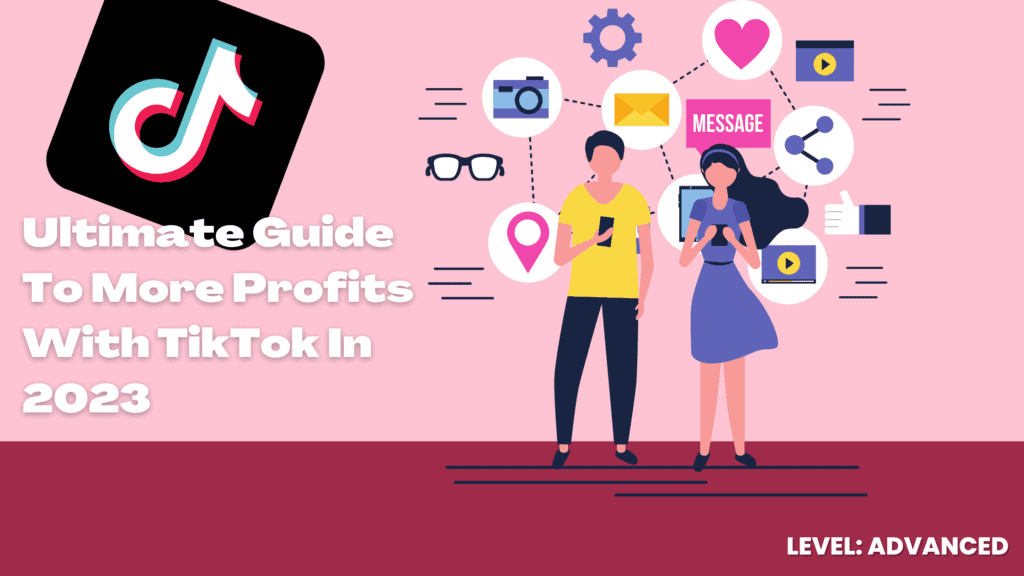Dominate Your Competition Using These Tactics (Because They Aren’t)
By now you’ve undoubtedly read at least a dozen articles about how you should be leveraging TikTok if you have an ecommerce brand. Heck, we’ve even written a few ourselves. Most go over the staggering stats that the social media platform boasts (like how it was the most downloaded app in 2021, US influencers have an 18% engagement rate on average, and 49% of users claim TikTok helped them make a purchase decision).
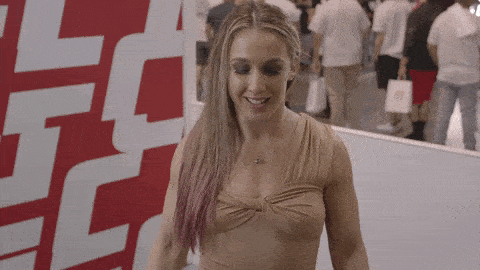
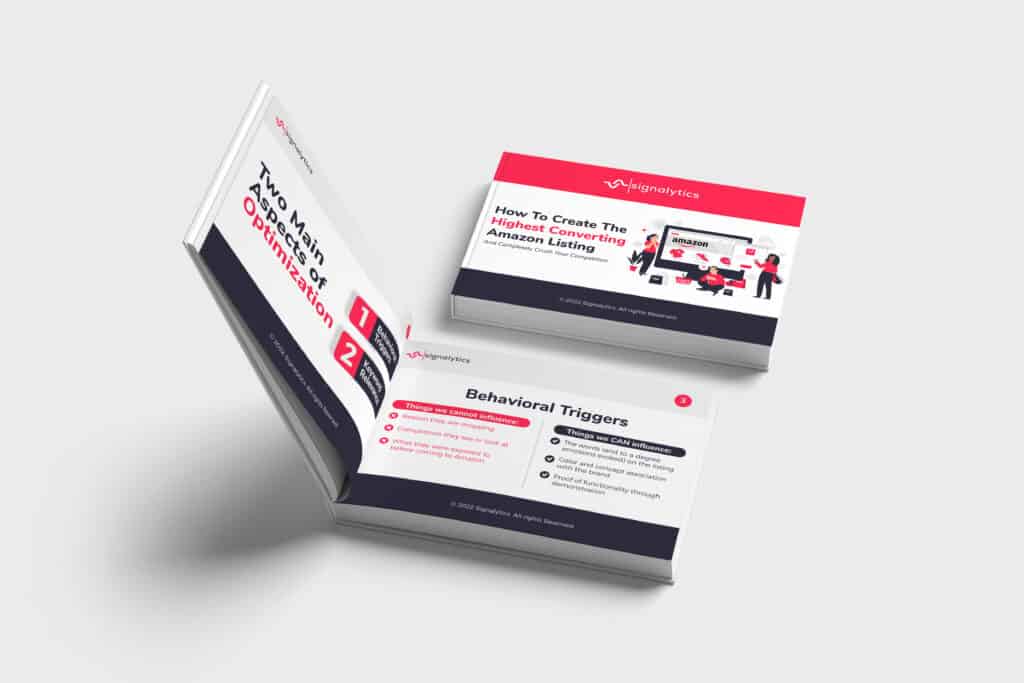
Get Our Internal Amazon Listing Optimization Operating System and increase conversions by 18%+ HERE 👇
We won’t belabor that point any further. The purpose of this article isn’t to convince you that you should have a TikTok strategy (by now we hope you realize you should). It is to explain exactly how to do it and do it well.
There are two ways to grow your brand on the TikTok platform outside of running paid ads. We suggest you engage in both for maximum scaling. The first way is to hire influencers to help spread the message of your brand and products. The second way is to build your own brand account on the platform.
Leveraging Influencers
One of the fastest and most effective ways to scale your brand is to get massive exposure on a big platform like TikTok. And one of the easiest ways to do that is by leveraging influencers.
Influencers have gotten sort of a bad rap, or negative associations, due to Instagram, but in this context it may be better to refer to them as content creators. These creators make a living (ideally) creating content about a variety of things; their life, their experiences, products they love, etc.
Within the context of Amazon and ecommerce, there appear to be two main types of content creators. They are lifestyle creators and shopping/deal creators.
Lifestyle vs Deal Shoppers
Lifestyle creators are typically affiliates and they make videos about any number of products that they feel may interest their audience. Sometimes they follow a niche, such as fashion or tech or home goods, etc. Sometimes they showcase products from any niche but only promote novel items (products that are new and unique).
Typically these videos will demonstrate the product and there will be a linktree link in the bio with the individual affiliate links or a link to their Amazon storefront.
Shopping/deal creators tend to promote any product offering a deal. Some focus solely on Amazon but many also include deals from Target, Walgreens, etc.
These videos can be as simple as showing the listing and then the coupon code, with no faces or voice, or as complex as demonstrating the product with a voiceover or camera-directed conversation.
Both of these creator types have audiences that are ready to buy, but those audiences are very different. Lifestyle audiences buy with less urgency, as they are passively deciding to give a novel product a try, or happen to be in need of the solution a featured product offers.
Deal seeking audiences buy with urgency because they know that coupons and discounts are typically limited in time or availability.
Lifestyle audiences may show some level of loyalty and community more so than deal seeker audiences, depending on how much engagement the creator encourages. A highly engaged audience that becomes a part of a community will often go to greater lengths to become involved with brands the creator endorses with enthusiasm.
Lifestyle audiences also seem much less price sensitive, whereas deal seekers tend to factor total price as a definite indicator of willingness to get involved in a promotion.
Both of these creator types and audiences play a huge role in helping brands gain sales and exposure.
How Effective Are Content Creators On TikTok?
Why does any seller promote their product on any platform? Because ultimately we all want more sales every day. The end goal of promos, discounts, PPC, keyword ranking….all of it comes down to our desire to increase sales.
With that in mind, let’s take a look at some content creator promotion examples…
First, we’ll start with the most basic type of creator. This creator doesn’t show a face, do any voiceover, or demo the product. They simply show the Amazon listing and then the coupon code.
They don’t have a very large following, but that doesn’t matter on TikTok. Here we see a promotion they did for a hammock chair that got just over 12,000 views (not stellar but not terrible).
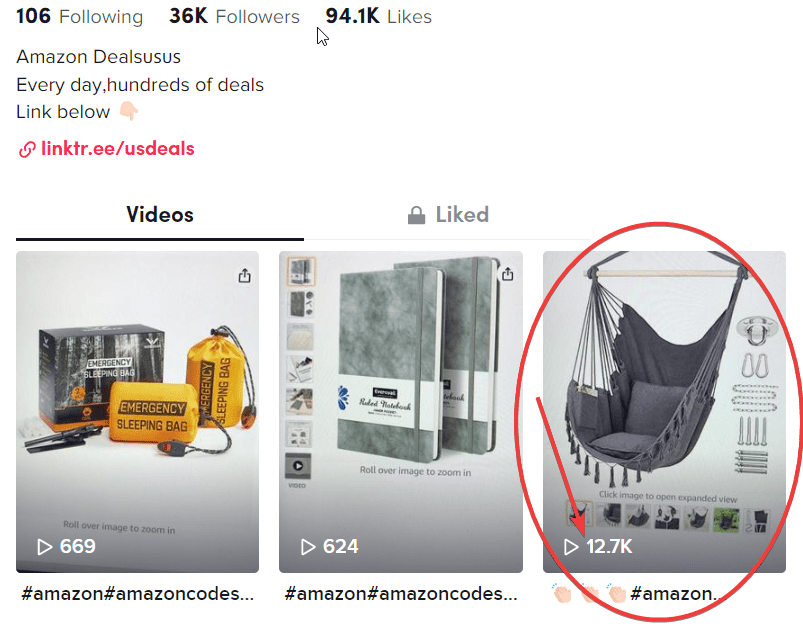
And here you can see that it absolutely impacted sales because over the next few days BSR dropped pretty significantly before beginning to return to “normal.”

Unfortunately BSR did appear to rapidly increase again, but we’ll discuss why in a bit. Let’s look at another example.
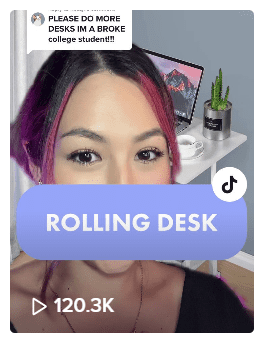
Here we have everyone’s favorite TikTok influencer, Gracey from @dealcheats, with a promotion for a rolling desk that got a modest amount of views (120k is modest for her).
Gracey has a pretty massive following of over 1 million ravenous deal seekers, so it isn’t a surprise that we see here BSR dropped dramatically very quickly, and it didn’t “recover” back to previous levels for over ten days.

Ok, so as you can see, deal shopper audiences can really help launch a product. And it doesn’t require a lot of followers (though more followers can mean more exposure).
But why does BSR keep going back to previous levels? Is it because these are deal seeking audiences?
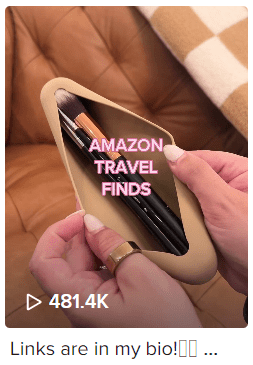
Nope. Here we have a travel makeup brush holder promoted by Rachel Meaders, arguably one of the largest lifestyle creators on the internet. This video also garnered over 450k views!
And here you can see that within two weeks of her promotion, even though BSR did dramatically plummet, it returned to pre-promotion levels.

So, we see that both deal shopper and lifestyle creators and their respective audiences are very effective at moving a lot of product quickly. And, in some instances depending on the type of audience cultivated, the type of content created, and the size of the audience, these effects can last for several days to weeks.
But then things appear to return to previous levels. So what’s the point?
Well, many promotions seem to end up this way, but not all of them do. Take a look…
Here we have a promotion for a waterproof smart cutting board that did very well. It got over 4 million views, so already we can see that people liked this product.
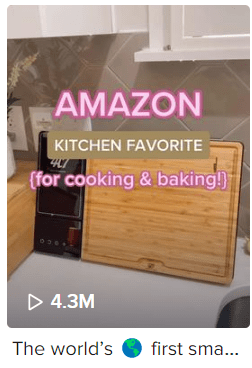
But here is the part everyone cares about. Look at the BSR. It went from over 350k to under 45k (for a product over $100 that’s not bad) and stayed there. It’s been well over a month now and BSR is holding strong.

That’s what we all want, right?
What Makes a Creator Promotion Successful?
There are a number of factors at play when a creator promotes your products on TikTok. Here are a few to pay attention to.
Audience/product fit. How well does the product align with the creator’s audience? You can figure this out by watching the creator’s videos. See if the products or concepts they promote fits a theme. If they do, then the audience is drawn to whatever that theme is.
Audience incentive. What is the audience’s incentive? If the creator is a deals and discounts creator, then the incentive is obviously a great deal. That means that a deeper discount or better deal will gain the most traction. If it is a lifestyle creator, then the incentive to purchase isn’t as urgent. That means that the product’s uniqueness will be a bigger attractor.
Average views. While views don’t guarantee success or failure, there is an indirect correlation between views and purchases. If for no other reason than only at most the number of people who saw the product can buy it. Creators of all sizes can get a lot of views, and the average views is a great indicator of how much engagement they get (because TikTok’s algorithm is next level). Look for average views over 10k, as that tends to be the benchmark for decent sales numbers.
Past performance. How do you know how well previous promotions performed? Simple. Look them up. Here’s how. First, go to the search bar in TikTok and simply search “amazon finds.” This is the primary keyword for creators posting things found on Amazon.
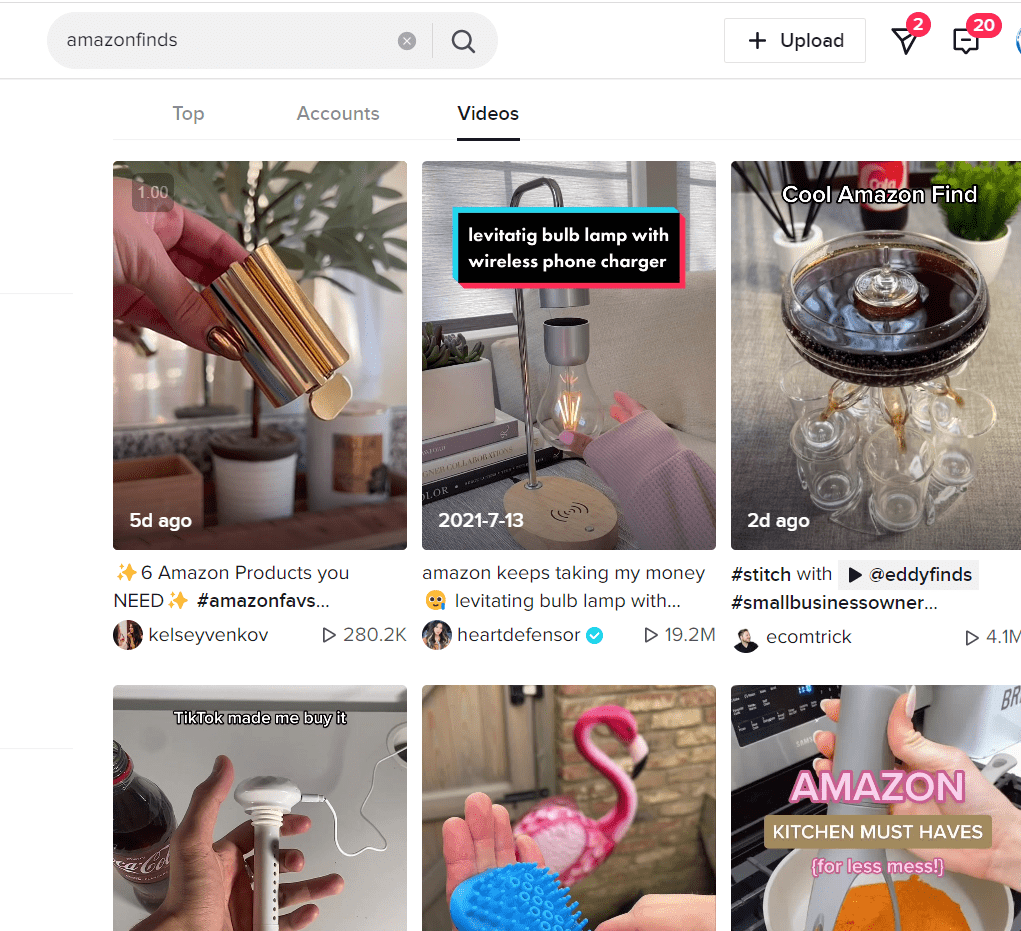
Then look at various creators accounts and click on their links. When you find an Amazon storefront, look at their videos and note the date that the video was posted and the product being promoted.
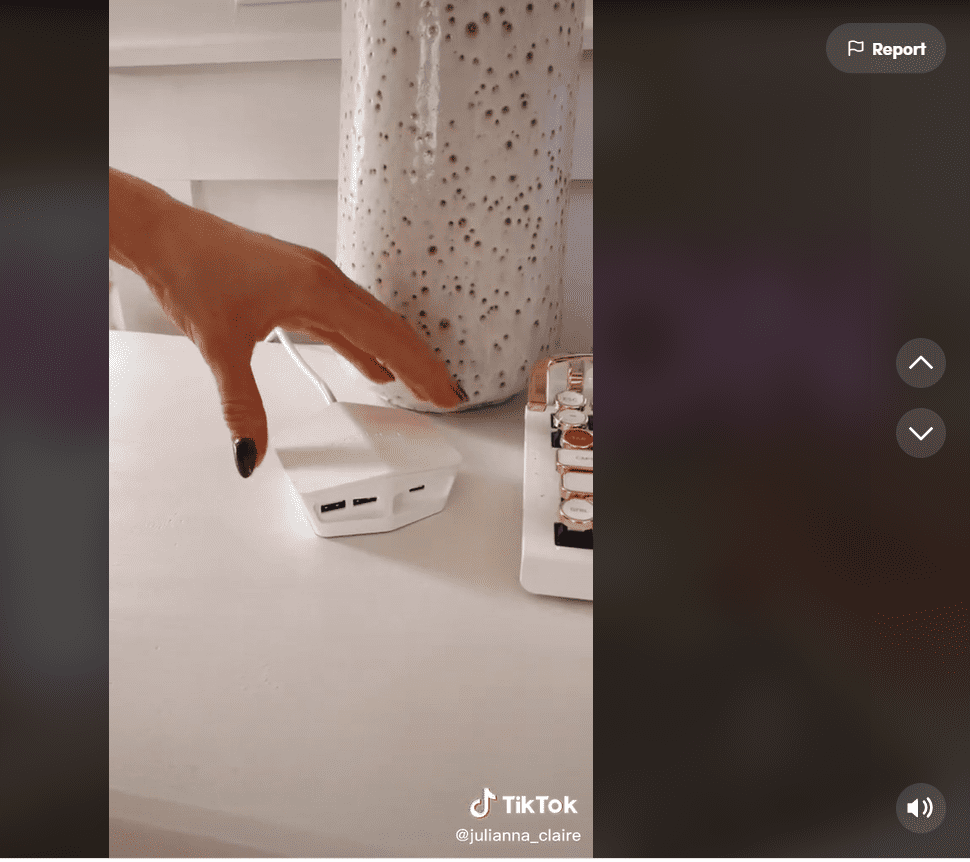
Then find the corresponding product in their storefront and, if you have the Helium 10 Chrome Extension, scroll down to look at the product’s BSR history. Note how much of a drop in BSR there was after the promotion. This will give you an idea of past performance.
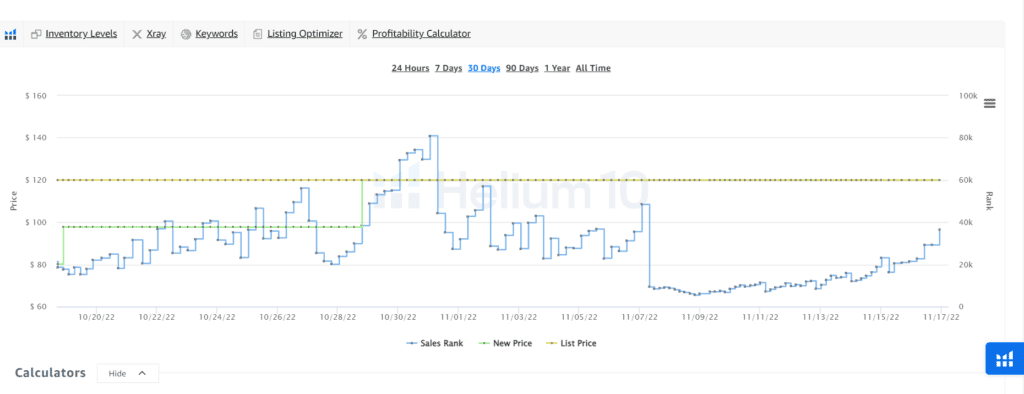
But…what if BSR has gone back to previous levels? That issue was never addressed!
The Real Reason TikTok Promotions Don’t Have Lasting Results (and What To Do About It)
We looked at dozens and dozens of TikTok promotions and their products. We discovered that massive sales could be had regardless of whether the creator was a discount/deals creator or a lifestyle creator. Regardless of whether they had huge followings or modest followings. Regardless of whether their videos got millions of views or only thousands.
What were the factors that seemed to determine whether a product maintained a low BSR (and therefore constant sales)?
OPTIMIZATION
Yes. That’s right. Listing optimization. We don’t want to be ambiguous about this. So let’s say it with our full collective chests:
Every. Single. Product. That. Did. Not. Sustain. Higher. Sales. Did. Not. Have. Optimized. Listings.
Their titles were always jumbled and stuffed with keywords, their images never featured people or faces, and there were never videos. One other common denominator (just as an interesting side note) is every single listing that returned to previous level BSR after a promotion had their brand name as the first word of their title.
Contrast that with the ones that were successful and remained successful. The things those listings had in common were:
- They used multiple creators (we saw their products on many influencer storefronts, for both lifestyle and deals).
- They had optimized titles (titles that were easy to read and understand, with clear benefit).
- They usually had lifestyle images that featured people and their faces (if not then there were people in their videos).
- They all had videos in their listing.
Here’s a great example.
This plug brand was featured by several creators both big and small, garnering anywhere from tens of thousands to hundreds of thousands of views.
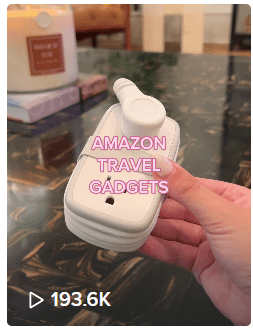
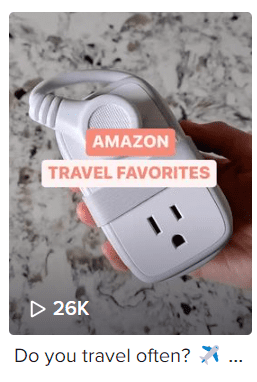
The listing is decently optimized, with a good title, and videos featuring their target demographic. They had all the prerequisites to ensure once they got the visibility other people outside of the creators’ fan base would purchase the product. And it paid off.
Here marks one of the last campaigns they did with a smaller account (though it appears they did most of the campaigns simultaneously). Shortly thereafter they sank in BSR and seemed to have remained there.

Tips On How To Get The Most From Your Influencer Campaigns
For Deals and Discount Creators:
- Discount appropriately. The more perceived value, the lower the discount has to be, but if it’s a “me-too” product the discount will need to be higher.
- Keep it under $50. Deal seekers will buy products that are more expensive but in much less volume.
- Limited time. Urgency works well with this audience.
- “Popular” products convert better than niche products.
For Lifestyle Creators:
- Product/audience fit. Make sure your product will likely resonate with the creator’s audience.
- Novelty is key. Higher ticket products are ok but they need to be unique.
- Video demonstration is satisfying. The “cooler” the demo video can be the more attention the product will get.
- Niche products can work. Again, because unique does well with this audience.
For Both:
- Clear call to action. Whatever you want the buyer to do (use a coupon code, just go buy the product) make sure it is straightforward and easy to understand.
- Easy to find. TikTok users don’t have the patience to search-find-buy and all of those tricks. It needs to be easy to find your product by clicking a link.
- Work with an engaging creator. Creators that show their face, use their voice, and/or do product demos get the best conversions (don’t judge creators that don’t have a lot of demos either…often that’s because brands don’t send them the product…for best results, send your product to your creator).
The Science Behind Why This Works
Here’s a quick rundown of the behavioral science behind why all this works…in a nutshell:
- Research shows people trust influencers (believe it or not).
- Research shows people trust those they know, hence faces and voices are key.
- A hundred years of advertising research shows that demonstrating the product works best.
- Video is the highest converting medium right now.
- Surveys reveal TikTok is a big driver in helping people make purchase decisions.
Building A Brand Presence On TikTok
Another very effective way to use the TikTok platform to scale is by growing a brand account. Many brands aren’t doing this because they are intimidated by the work. It requires consistent creation of video content, which doesn’t appeal to everybody.
Be that as it may, if you have a brand and you are not representing yourself on TikTok you are leaving money on the table. Period. Short-form video is clearly the top choice for content medium today, and it is consumed by all demographics.
Unless you are selling life-insurance or AARP memberships (and still, even then nowadays), there is a really good chance that people who will buy your product are on TikTok. And finding them before your competitors do is a great way to ensure your brand’s growth.
The next question is, though, how do you grow an account on TikTok? It is much easier said than done to be clear. However, we’ve done this ourselves (we built a branded account to over 75k followers), worked with brands who have done this, and have researched this topic extensively, so we feel confident we can give you a blueprint that will work.
Examples Of Brands “Killing It” On TikTok (and How They Are Doing It)
First, let’s start with the big, recognizable brands. They typically represent what we hope to one day achieve when we have a similar budget.
Chipotle
The Chipotle brand has two million followers and gets an average of tens of thousands of views per video.
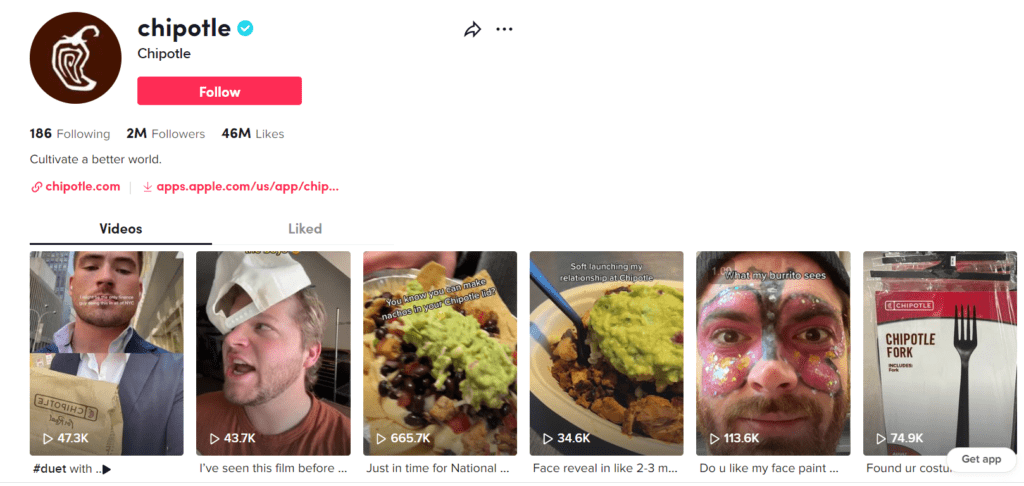
One of their strategies for growth was leaning into challenges.
Challenges are a concept that TikTok caters to heavily. So much so that there was (and likely still is) a variable in their code that referenced challenges for each profile. This is because TikTok recognized that challenges were a great way to grow the platform as a whole.
First, Chipotle started the #ChipotleLidFlip challenge, which featured a quick and seemingly simple action where you take a Chipotle to-go bowl and use it to flip the lid into the air and have it land back on the bowl.
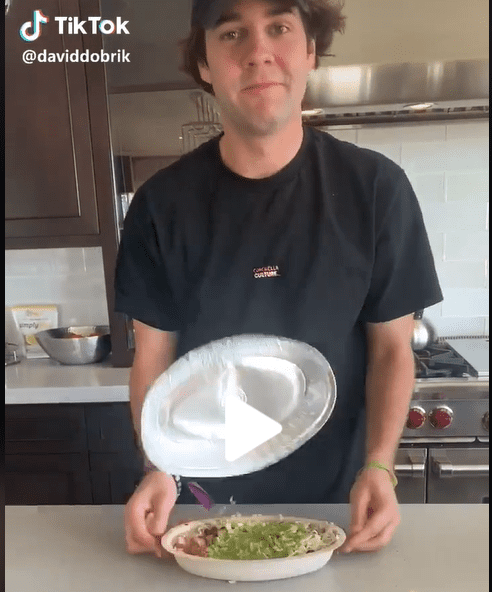
The challenge garnered hundreds of videos and a collective hundreds of millions of views, which undoubtedly translated into more foot traffic into their stores.
However, they didn’t stop there. Next Chipotle created the #GuacDance challenge, capitalizing on TikTokers’ love for choreography. While the challenge didn’t go as viral as the flip lid challenge, it did get a lot of people dancing and talking about Chipotle.
Aside from the challenges, Chipotle is also leaning into Gen Z’s interest in web3 and created an entire Chipotle and spooky Halloween themed maze in Roblox. Aside from the store players also could put on Chipotle themed costumes in the game. People who visited the store in Roblox were able to get free and discounted burritos in physical stores.
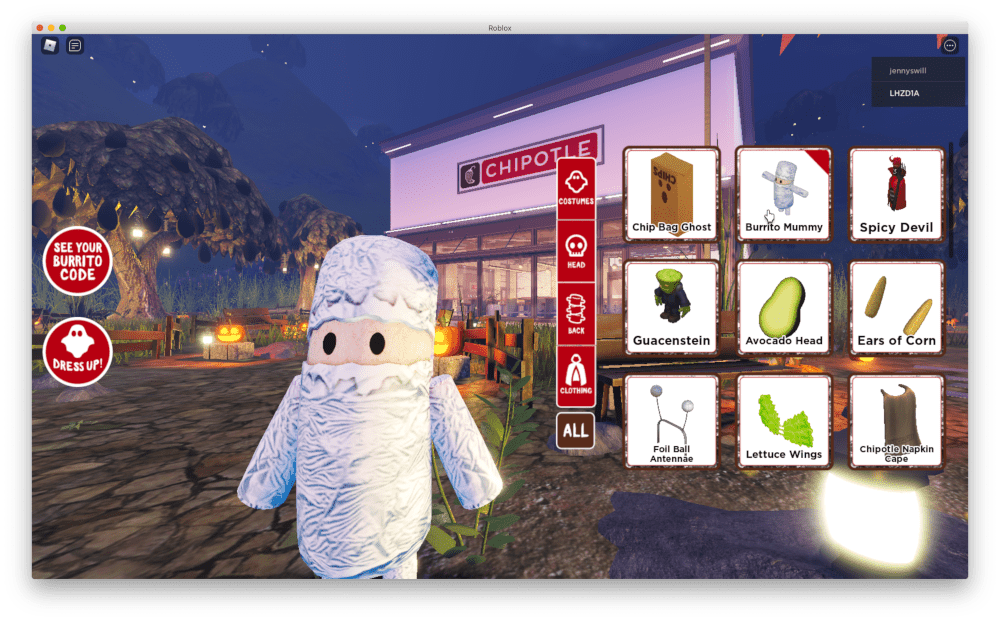
Guess
Guess built a following of just over 125k capitalizing on hashtags and trends. On the TikTok platform there is no shortage of trends, dances, and viral sounds, and sometimes you don’t have to go out and create your own. If you can participate in what the culture has already built, you can capitalize on virality.
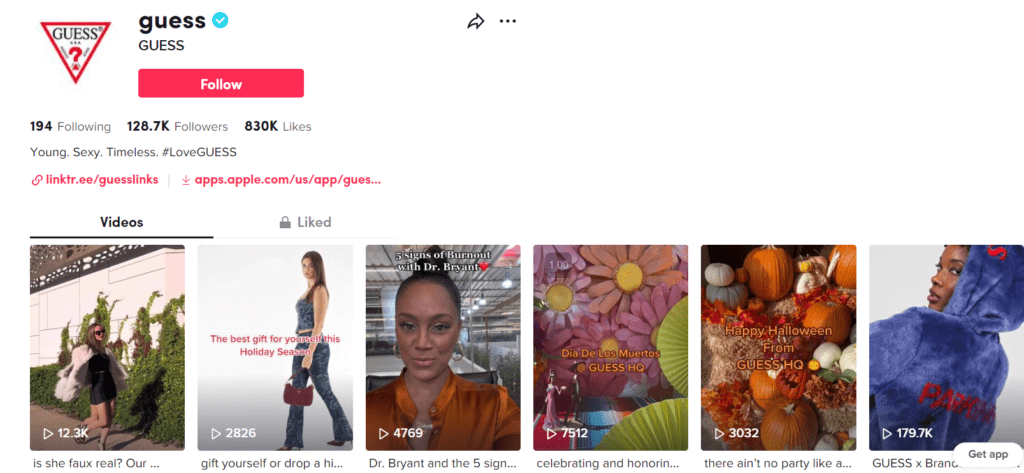
Here Guess participated in a transition trend that featured people showing off their Guess clothing.
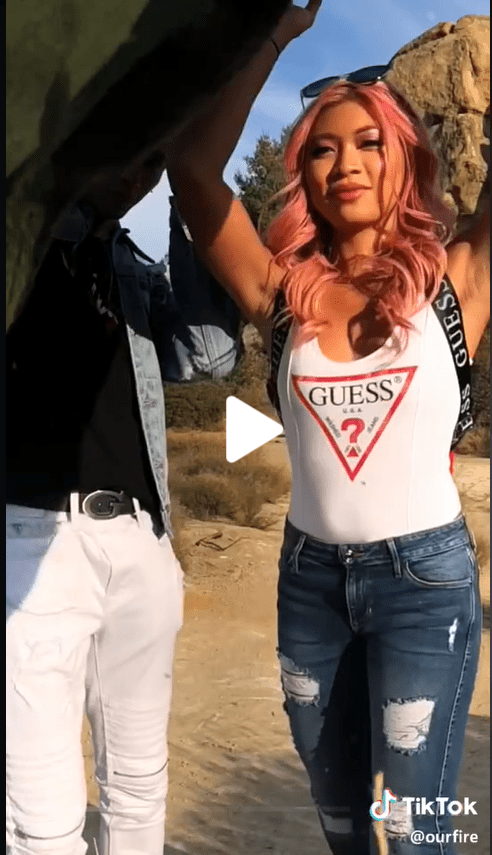
F’real
F’real milkshakes just does TikTok right. They utilize influencers, they make videos that are 7 to 15 seconds long, they use popular sounds, they showcase their brand without being salesy, and they leverage memes A LOT. Basically, they speak to the younger generation. As a result, they have almost a million followers, a tremendous amount of engagement, and have built a hell of a recognizable brand.
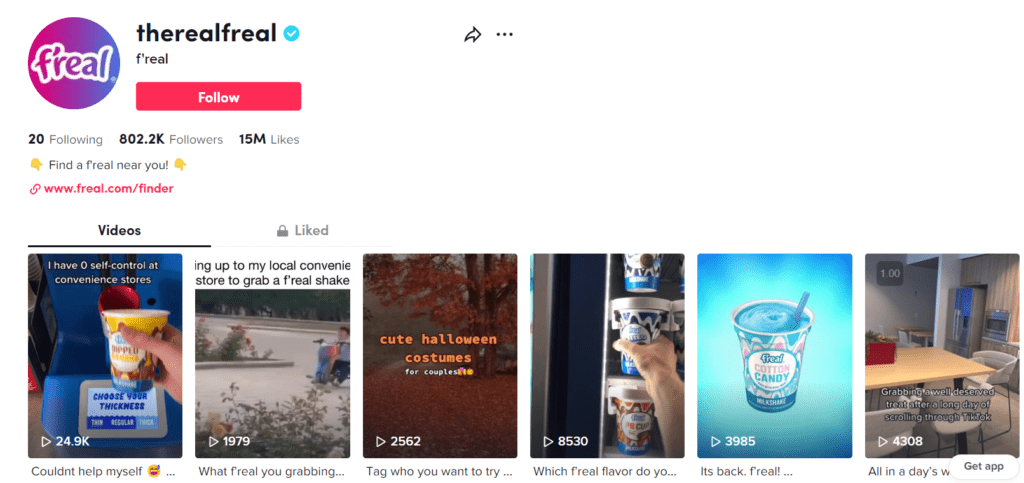
These are great examples of big brands doing things right, but what about people without the crazy budgets the big brands have? Normal small businesses have less production equipment, less location opportunity, and less celebrity endorsements.
Never fear, because TikTok is the platform of the people. Plenty of small brands have grown huge followings that resulted in amazing sales numbers.
Enchanted Scrunch
The scrunchy brand Enchanted Scrunch, for example, was started only a year ago (in 2021) and boasts just shy of 200k followers on TikTok.
They claim their first video got 15k views and scored ten orders. Now they have a lot more followers and make videos about giant orders regularly.
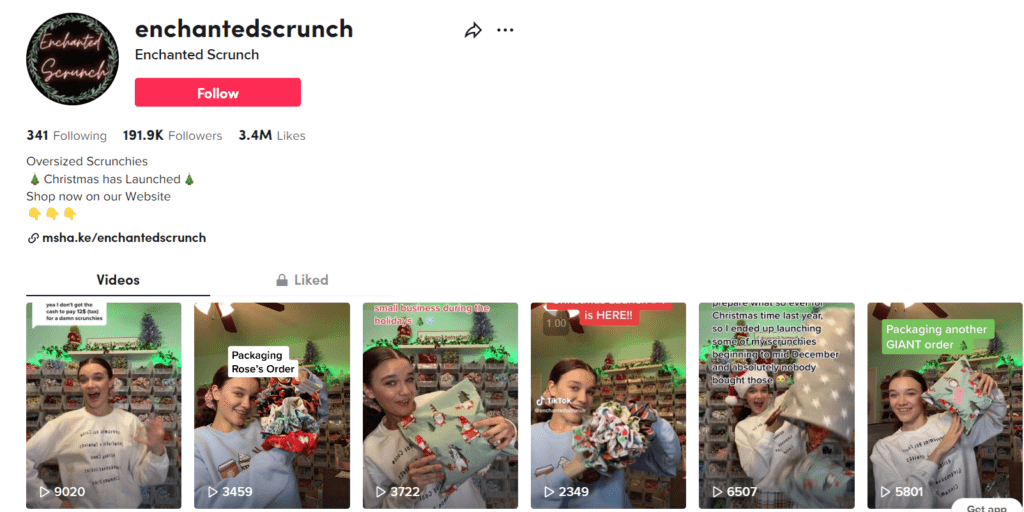
The video formats are simple. It’s a young lady showcasing the scrunchies. She talks about new designs and shares how much the brand is growing. Simple as the format may be, the account has amassed over 3 million likes, so there are plenty of potential buyers seeing what they have to offer.
Peachy BB
Peachy BB is a slime company that makes unique and colorful slime. They started their TikTok account in late 2019 and have amassed over 5 million followers!
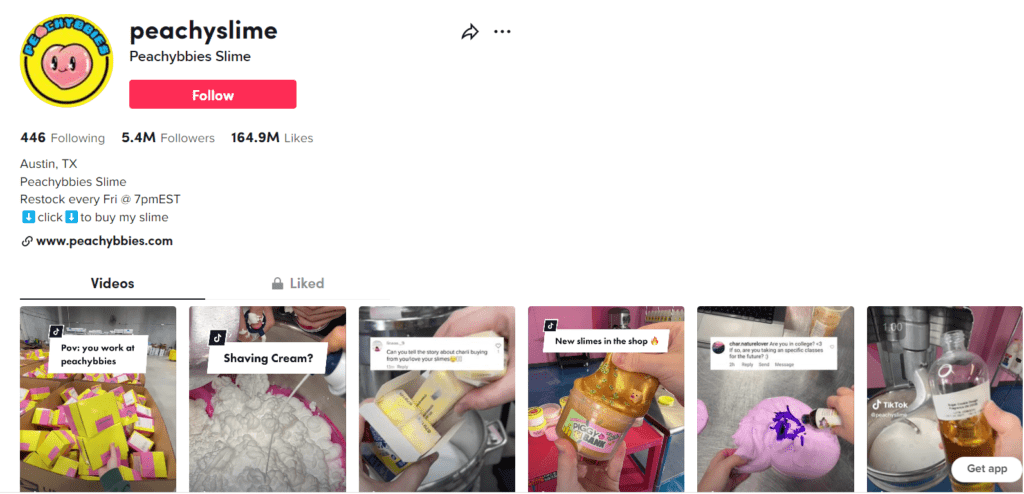
The videos are very satisfying to watch as they all feature the making of different types of slime. They include weird and interesting ingredients (such as cereal or hair dye). They also feature the faces of the people who run the brand.
Is it working? Well, here we are three years later, and if you go to their website on any given day, their entire store is probably sold out. Just about every time they introduce a new slime product, the whole store sells out of all its inventory.

That sounds like a good “problem” to have.
Tips On How To Grow Your Brand’s TikTok Presence
No two brands are the same with regard to how they have grown. That being said, there are some ways that will help you gain visibility and thus attract your ideal audience…
- Incorporate trends. Participate in challenges, transitions, and dance trends to get more views and thus more followers. Make sure to represent your brand fully though, so everybody is aware of who you are.
- Incorporate popular sounds. Sounds are one of the biggest drivers with regard to content on TikTok. Use sounds you can lip sync or dance to that will grab people’s attention.
- Create your own AR filters. Branded filters are a little-known hidden gem for brands. Plenty of agencies offer this as a service, or you can check out TikTok Effect House yourself and give it a shot.
- Create your own sounds. Using trending sounds is great, but you cannot use most of them in ads or other promotions. A great way around this is to create your own sounds. That way you can also create sounds and music that are themed around your challenges and hashtags. You can hire freelancers to create these sounds for you.
- Use hashtags. Hashtags are one of the ways that people find content on TikTok. When looking for a challenge or sound, hashtags are almost always used. Help control the narrative around your brand by using popular hashtags as well as creating your own.
- Be consistent. This is a no-brainer but it needs to be said. TikTok’s algorithm can be biased toward recency but people are fickle. If a video doesn’t get the right amount of engagement within the first few minutes its distribution will be stunted. That means that the more you post the greater the chances of going viral.
- Be authentic. I know we said that most demographics are consuming TikTok media, but the platform is largely dominated by younger millennials and Gen Z and these guys can see right through a facade. You cannot be fake with them or they won’t give your content the time of day. Be real. Be authentic. Let them see who you are, what you represent, and why you do what you do. They will reward you with views and follows.
Aside from these tips, make sure you are clear in your bio about who you are and what you offer. Have a clear call to action as well. And above all else HAVE FUN!
If your brand would like to work with the biggest and most successful Amazon content creators on TikTok, Signalytics can help. Just reach out here and we can discuss all your TikTok related needs. 👇👇
[engagebayform id=”6087736853790720″]
And of course, if you want to ensure your TikTok campaigns offer lasting results, schedule a FREE listing audit and our team can tell you whether your listings are influencer-promotion-ready. Schedule your free audit here 👉 https://ebooks.signalytics.ai/listing-audit-questionnaire/

